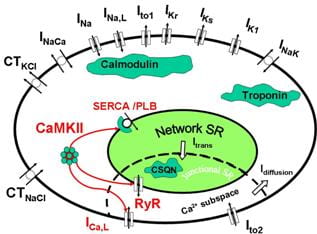Models and Simulations | Ion Channels | Cardiac Cells | Cardiac Tissue
The cornerstone tool in the lab is the cardiac ventricular action potential (AP) model, containing mechanistically based, detailed models of ionic currents and Ca 2+ handling processes. We continually refine our models to incorporate new experimental findings. Ionic current models can be incorporated in a modular fashion in the whole-cell model. The ventricular AP model can be incorporated into multicelluar tissue models to study basic mechanisms of conduction and cardiac arrhythmia.
At present, we have published numerous studies on basic mechanisms of excitation, repolarization, and rate dependent behavior as they relate to arrhythmogenesis using the Luo-Rudy dynamic (LRd) and Hund-Rudy dynamic (HRd) ventricular AP models (see Publications). These models were constructed to reflect guinea-pig and canine electrophysiology, respectively. A third model, specific to normal human ventricular electrophysiology, is currently being developed in our lab.
